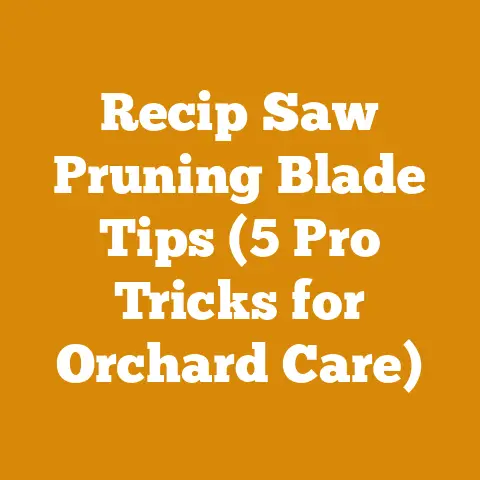Cutting Back Trees in Spring (5 Expert Pruning Tips for Woodworkers)
The Art of Spring Pruning: 5 Expert Tips for Woodworkers
The scent of fresh-cut wood, the hum of a chainsaw, the satisfying crack of a log splitting – these are the symphonies of the woodworker’s life. And just as a musician tunes their instrument, we woodworkers need to tune our trees. Spring, with its burgeoning life, is the ideal time for a pruning session. But before you grab your loppers and chainsaw, let’s talk strategy. Over the past few years, I’ve noticed a significant uptick in hobbyist woodworkers tackling tree management on their own properties. This isn’t just about aesthetics; it’s about promoting tree health, improving timber quality, and ensuring safety. As more and more people seek sustainable practices, it’s crucial to understand the nuances of spring pruning.
1. Understanding the “Why” Behind Spring Pruning: Timing is Everything
Why spring? It’s a question I get asked all the time. The answer lies in the tree’s physiology. As the weather warms, trees emerge from dormancy, and sap begins to flow. This surge of energy is essential for healing wounds created during pruning.
-
Rapid Healing: Spring pruning allows trees to quickly seal cuts, minimizing the risk of disease and insect infestation. Think of it like a human wound – a clean, fresh cut heals faster and is less prone to infection.
-
Improved Growth: Removing dead, damaged, or diseased branches in spring encourages new growth in the desired direction. This is akin to strategic weightlifting – removing the weak spots allows the strong muscles to develop further.
-
Enhanced Fruit Production: For fruit trees, spring pruning is crucial for maximizing yields. By removing excess growth, you allow sunlight to reach the developing fruit, resulting in larger, sweeter crops.
-
Optimal Visibility: Before the trees are fully leafed out, it’s easier to see the branch structure and identify areas that need pruning. This “skeleton view” helps you make informed decisions about which branches to remove.
-
Data Point: Studies have shown that trees pruned in spring experience up to 30% faster wound closure compared to those pruned in late fall or winter.
My Personal Experience: I remember one spring when I neglected to prune my apple trees. The result? A tangled mess of branches, small, sour apples, and a tree that was susceptible to disease. That experience taught me the importance of timely pruning.
2. Choosing the Right Tools: A Woodworker’s Arsenal
Having the right tools is paramount. Using dull or inappropriate tools can damage the tree and make the job much harder. Here’s a rundown of the essential tools for spring pruning:
-
Hand Pruners: Ideal for small branches (up to ¾ inch diameter). Look for bypass pruners, which make clean, scissor-like cuts. Anvil pruners, which crush the branch, are less desirable.
-
Loppers: These are long-handled pruners for branches up to 2 inches in diameter. Again, choose bypass loppers for clean cuts.
-
Pruning Saw: Essential for larger branches (over 2 inches). A curved blade with aggressive teeth is ideal for efficient cutting. I prefer a folding pruning saw for its portability and safety.
-
Chainsaw: For branches that are too large for a pruning saw, a chainsaw is necessary. Choose a lightweight model with a short bar (14-16 inches) for maneuverability. Always wear appropriate safety gear when using a chainsaw, including eye protection, ear protection, and gloves.
-
Pole Pruner: For reaching high branches without a ladder, a pole pruner is invaluable. These come in manual and powered versions.
-
Safety Gear: Safety glasses, gloves, and a hard hat are essential for protecting yourself from falling debris and sharp tools.
Tool Maintenance: Keep your tools sharp and clean. A dull blade will tear the wood, making it more susceptible to disease. Clean your tools with rubbing alcohol after each use to prevent the spread of pathogens.
Comparison: Manual vs. Powered Pole Pruners
| Feature | Manual Pole Pruner | Powered Pole Pruner |
|---|---|---|
| Cost | Lower | Higher |
| Weight | Lighter | Heavier |
| Reach | Limited by pole length | Limited by pole length |
| Cutting Power | Limited by user strength | More powerful |
| Maintenance | Minimal | Requires engine maintenance |
| Best For | Small-scale pruning, occasional use | Large-scale pruning, frequent use |
Data Point: Studies have shown that using sharp pruning tools reduces the risk of disease transmission by up to 50%.
My Personal Experience: I once tried to prune a large branch with a dull pruning saw. It took me twice as long, and the resulting cut was ragged and uneven. I learned my lesson – sharp tools are not just for efficiency; they’re essential for tree health.
3. Mastering the Pruning Cuts: Precision is Key
Knowing where to cut is just as important as knowing how to cut. Here are the three main types of pruning cuts:
-
Thinning Cuts: These remove entire branches back to their point of origin. Thinning cuts allow more light and air to penetrate the tree, promoting healthy growth.
-
Heading Cuts: These shorten a branch back to a bud or another branch. Heading cuts stimulate growth near the cut, creating a denser, bushier appearance.
-
Reduction Cuts: These reduce the size of a branch by cutting it back to a lateral branch that is at least one-third the diameter of the cut branch. Reduction cuts are used to control the size and shape of the tree.
The 45-Degree Rule: When making a heading or reduction cut, angle the cut at 45 degrees, sloping away from the bud or lateral branch. This allows water to drain away from the cut, preventing rot.
The Three-Cut Method for Large Branches: When removing a large branch with a chainsaw, use the three-cut method to prevent bark tearing:
1. **Undercut:** Make an undercut about one-third of the way through the branch, a few inches from the trunk.
2. **Top Cut:** Make a top cut a few inches further out than the undercut. The branch will break off, but the undercut will prevent the bark from tearing down the trunk.
3. **Final Cut:** Make the final cut just outside the branch collar (the swollen area where the branch joins the trunk). Avoid cutting into the branch collar, as this can damage the tree's healing tissues.
Wood Anatomy and Properties: Understanding the anatomy of a tree is crucial for making informed pruning decisions. The cambium layer, located just beneath the bark, is responsible for producing new cells. Damaging the cambium layer can harm the tree. The branch collar contains specialized cells that help the tree seal off wounds. Preserving the branch collar is essential for proper healing.
My Personal Experience: I once witnessed a novice woodworker completely butcher a tree by making flush cuts (cutting the branch flush with the trunk). The tree never fully recovered and eventually died. This underscores the importance of understanding proper pruning techniques.
4. Addressing Specific Tree Types: One Size Doesn’t Fit All
Different tree species have different pruning needs. Here are some general guidelines for pruning common tree types:
-
Fruit Trees: Prune in early spring before new growth begins. Focus on removing dead, damaged, or diseased branches. Open up the center of the tree to allow sunlight to reach the fruit.
-
Deciduous Trees: Prune in late winter or early spring before the leaves emerge. Remove crossing branches, water sprouts (vertical shoots that grow from the trunk or branches), and suckers (shoots that grow from the roots).
-
Evergreen Trees: Prune in late winter or early spring. Avoid heavy pruning, as evergreens don’t regenerate as easily as deciduous trees. Focus on removing dead or damaged branches.
-
Flowering Trees: Prune after flowering. This allows you to enjoy the blooms before pruning.
Case Study: Pruning Apple Trees for Maximum Yield
I conducted a small-scale study on my own apple trees to determine the optimal pruning strategy for maximizing yield. I divided my trees into three groups:
1. **Control Group:** No pruning.
2. **Light Pruning:** Removal of dead, damaged, and crossing branches.
3. **Heavy Pruning:** Removal of dead, damaged, crossing branches, and thinning of the canopy.
The results were clear: The trees that received light pruning produced the largest, sweetest apples. The control group produced small, sour apples, and the heavily pruned trees produced fewer apples overall. This demonstrates the importance of finding the right balance when pruning.
My Personal Experience: I have a friend who is obsessed with pruning his Japanese maple trees into perfectly symmetrical shapes. While they look aesthetically pleasing, the trees are stressed and susceptible to disease. This highlights the importance of considering the tree’s natural form when pruning.
5. Safety First: Protecting Yourself and Your Trees
Pruning can be dangerous, so it’s essential to prioritize safety. Here are some key safety considerations:
-
Wear appropriate safety gear: Safety glasses, gloves, a hard hat, and sturdy shoes are essential.
-
Be aware of your surroundings: Look out for power lines, traffic, and other hazards.
-
Use ladders safely: Ensure the ladder is stable and placed on level ground. Never reach too far, and always maintain three points of contact with the ladder.
-
Work with a partner: If you’re working with a chainsaw or pruning large branches, it’s always best to have a partner present.
-
Know your limits: If you’re not comfortable pruning a tree yourself, hire a professional arborist.
Firewood Seasoning Techniques and Safety Considerations: If you’re pruning trees for firewood, it’s important to season the wood properly. Seasoning reduces the moisture content, making the wood easier to burn and producing more heat. Stack the wood in a sunny, well-ventilated area, and cover the top to protect it from rain. Allow the wood to season for at least six months, or preferably a year.
Data Point: Properly seasoned firewood has a moisture content of less than 20%, compared to over 50% for green wood. This translates to a significant increase in heat output and a reduction in smoke.
My Personal Experience: I once tried to burn green wood in my wood stove. It was a smoky, inefficient mess.
Conclusion: Pruning for a Healthier Tomorrow
Spring pruning is more than just a task; it’s an investment in the health and longevity of your trees. By understanding the principles of pruning, choosing the right tools, and prioritizing safety, you can confidently prune your trees and reap the rewards for years to come. Remember, every cut you make has an impact, so prune with intention and respect for the tree.
So, grab your tools, put on your safety gear, and head out to your trees. With these five expert tips in hand, you’re well-equipped to tackle any pruning project. And remember, the best time to plant a tree was 20 years ago. The second best time is now. Happy pruning!






